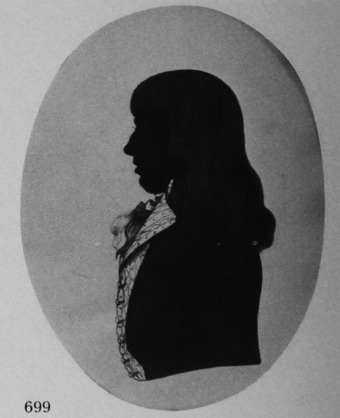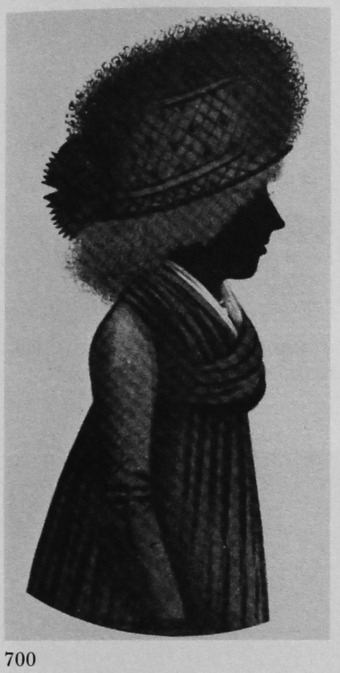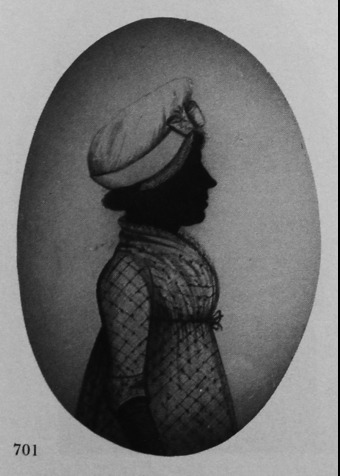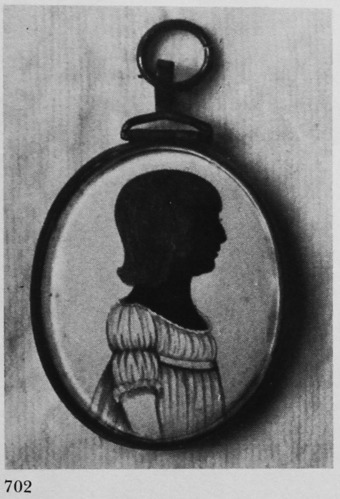Buncombe, Charles (McKechnie Section 2)
See Section Seven for main entry on Buncombe, Charles and John
We are concerned here only with those silhouettes which Charles Buncombe painted in black, or shades of black and grey, on card. All the surviving examples of his work in this category date from before 1800. Those profiles which he (or in due course his son John, who probably became his assistant) painted, and which show details of the sitter's clothing partly in colour, are discussed in the main entry on him and his son in Section Seven.
Here I shall discuss a few silhouettes which either bear an inscription (such as 'Buncombe, Newport, Isle of Wight') or which can be attributed to Charles Buncombe as a result of stylistic comparison. In fact, previous writers have ascribed these silhouettes to John Buncombe. In the main entry, however, I explain how recent research by Mrs E. M. Andrews seems to establish beyond doubt that all the pre-1800 work attributable to 'Buncombe', as well as a large proportion of the post-1800 work, was by Charles Buncombe. It appears that Charles Buncombe was a schoolmaster who lodged with an ironmonger named George Smith in High Street, Newport, Isle of Wight, and also in the house of a Mrs Salter, in the same street. Mrs Andrews' research also established that John Buncombe was in any case almost certainly not born until after 1800, and could not have taken any of the pre-1800 silhouettes.
It will be seen from the illustrations that Charles Buncombe's black silhouettes have an individual, precise, almost doll-like quality. The clothing is carefully and thoughtfully drawn in shades of thinned black, with the skilful addition of gum arabic to strengthen shadows and the darkest parts of the portrait. The transparency of the thin dresses worn by young women at the end of the eighteenth century is clearly shown, although the actual brush strokes with which this part of the work is executed are not especially fine. On all Buncombe's profiles in this category, the faces are in dead black and expression is shown on the features; the eyelash, which on his later work Buncombe painted with a singular 'blob' at the tip (see Section Seven), is not so treated on these early examples of Buncombe's work. The artist is not afraid to use a firm, thick stroke to indicate folds of heavy material. On these early silhouettes, Buncombe did not paint hair as he was to paint it later; he usually indicated the mass of the hair by a thick mass of thinned pigment, which might be divided by thicker strokes to show individual locks.
In the profile (1795) of a boy which I have illustrated, Buncombe used an especially fine brush to render the hair, which is executed with very fine strokes. Equally well painted is the boy's elegant waistcoat.
699
On most of Buncombe's extant black silhouettes the image is continued to the base of the oval, without a bust-line termination. On those examples which do show the termination Buncombe placed this lower than was customary in bust-length work.
These black silhouettes, most of which depict the members of local families and were probably commissioned to be hung in the home, survive in a variety of contemporary frames. (Most of Charles Buncombe's post-1800 silhouettes represent soldiers, who had no permanent domestic habitat, and the majority of these were sold unframed).
It may be hard to reconcile the style of the early work described here with some of the later work discussed in Section Seven; nevertheless, in the light of the available evidence it must be concluded that most of it, at any rate, is by the same hand. It must also be remembered that Buncombe was much more prolific after 1800, and would therefore not have had the time to spend on the kind of minute, exquisite detail which is characteristic of his early work. In any case, the passage of thirty years may well have wrought some change in his style.
Ills. 699-702

Unknown man
Silhouette painted on card
1795
3½ x 2¾in./90 x 70mm.
Frame: square, hammered brass
Inscribed on the reverse, ‘By Buncombe, Newport, Isle of Wight, 1795.’
M. A. H. Christie collection

Unknown young woman
Silhouette painted on card
1798
3½ x 2¾in./90 x 70mm.
Frame: pearwood
Inscribed on the reverse, ‘By Buncombe, Newport, isle of Wight, 1798.’
M. A. H. Christie collection

Unknown young woman
Silhouette painted on card
1799
3½ x 2¾in./90 x 70mm.
Frame: pearwood
Inscribed on the reverse, presumably in the artist’s hand. ‘By Buncombe, Newport, Isle of Wight, 1799.’
J. A. Pollak collection

Gilt metal locket, containing a silhouette of an unknown girl, painted on card by Charles Buncombe, c. 1797-98.
Size of locket: 1½ x 1¼in./39 x 32mm.
This silhouette can definitely be ascribed to Buncombe, on stylistic grounds. The attribution is supported by the fact that this silhouette was formerly in the possession of Frederick Poole, who lived in Newport, Isle of Wight.
R. Kilner collection
